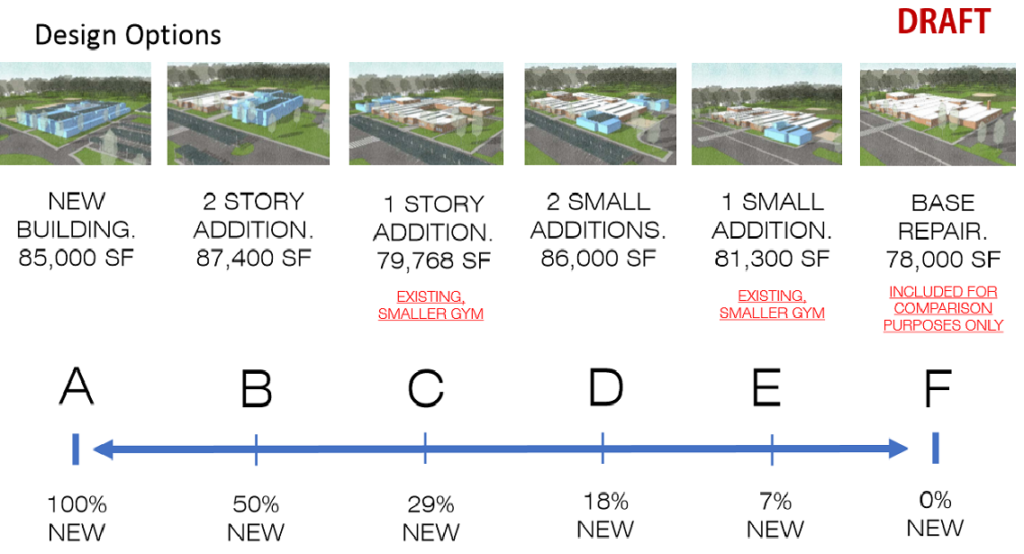Elementary School Building Project Update

Outline of options from a preliminary Fort River Building Committee report.
The process that will guide the next elementary school building project is off to a slow start.
On December 11, 2019, Amherst learned that it was accepted back into the Massachusetts School Building Authority’s (MSBA) pipeline, on the second attempt after the failed project that divided the town in 2016. Since then, five of the six requirements were met (each just before the deadline), a critically important requirement is overdue, and the first (and still unavailable for viewing) meeting of the Elementary School Building Committee (ESBC) was held.
Most Building Committee members were appointed by the Town Manager, in a process that has been criticized as lacking transparency. A list of the applicants for the three resident spots was formally requested by this reporter in a public records request but was denied by the Town Manager. Town attorneys opined that this information was off-limits because these volunteer Committee members are considered employees of the town. This policy differs from the appointment process of neighboring Northampton, where the names of resident applicants to town committees are readily available to the public.
Since the controversial 750-student, grade re-configuration/consolidation project at the Wildwood site failed to garner the required support to move forward, two elementary school feasibility studies, a facility use study of the middle and high school, and an initial exploration of moving sixth grade to the middle school have been conducted. This body of work provides analysis that the Building Committee will need to consider as it proceeds with its work.
The Fort River Feasibility Study, completed in fall 2019, produced multiple building options — with estimated costs — for varying degrees of renovation and new construction, all compliant with the Town’s Net Zero Buildings By-Law. Likewise, the Crocker Farm Feasibility Study, completed this summer, provided design options and estimated costs for the work needed to bring that building into compliance with safety, educational, and structural needs as well as the costs for its expansion should it serve as the second of a two-school elementary school system with Fort River and Wildwood being consolidated into one building.
Much of the decision-making around the current building project hinges on whether sixth grade is moved from the elementary to secondary level as enrollments will, in large part, determine the scope of the project. The study of this possible transition, however, stalled at the beginning of 2020. A final report of the advisory group was not completed or presented to the Amherst School Committee, and a deeper analysis of logistical and fiscal considerations planned for the summer was not undertaken.
These studies were not discussed at the October ESBC meeting. The one item on the agenda – to elect a chair and vice chair – was deferred to the next meeting as multiple committee members had not completed the required “swearing in” and training needed to serve on a town committee.
Five of the six documents that that were due in the first 180 days of the “Eligibility Period” that formally began on May 1, 2020 have been submitted. The Enrollment Certification, however, has not been completed in the timeline specified by the agreement with the MSBA. This document will determine what size project the state will reimburse. Given the Superintendent’s commitment to schools with no more than 600 students, in a K-5 or K-6 configuration, it will also constrain the options that the ESBC will study.
The preliminary enrollment figures from the MSBA showed a projected enrollment of up to 1200 students in K-6 by 2029. This is significantly higher than the figures presented to date by the District but Superintendent Morris cautioned that “The information is preliminary and likely to change, so I will wait until the final enrollment determination by the MSBA.”
Whatever elementary building project emerges must be considered in the larger context of the other major capital projects, including the Jones Library, South Amherst fire station, Department of Public Works (DPW) facility, senior center, Regional athletic fields, other large infrastructure needs at the middle and high school, and others. The Town Manager and other leaders have indicated that the MSBA project will likely require a debt exclusion override to cover the town’s share of the cost. However, it has not yet been ascertained whether work on Crocker Farm — if related to any possible consolidation plan — could be considered part of the MSBA project and therefore also eligible for state reimbursement. The impact of the pandemic on both the Town’s and individual’s fiscal health and implications for building design have yet to be fully realized.
